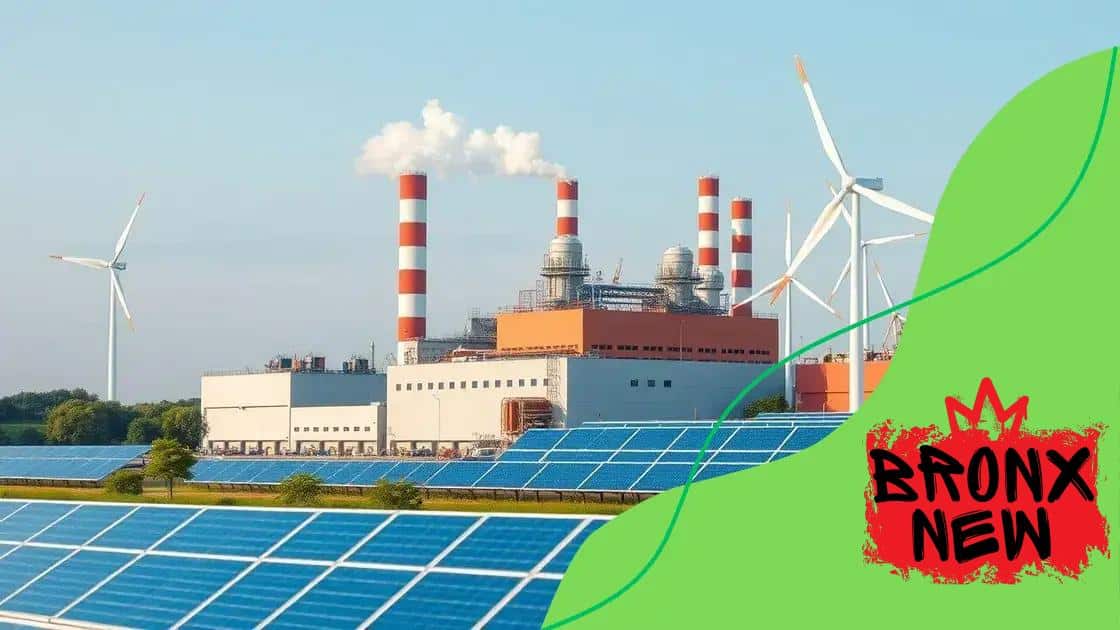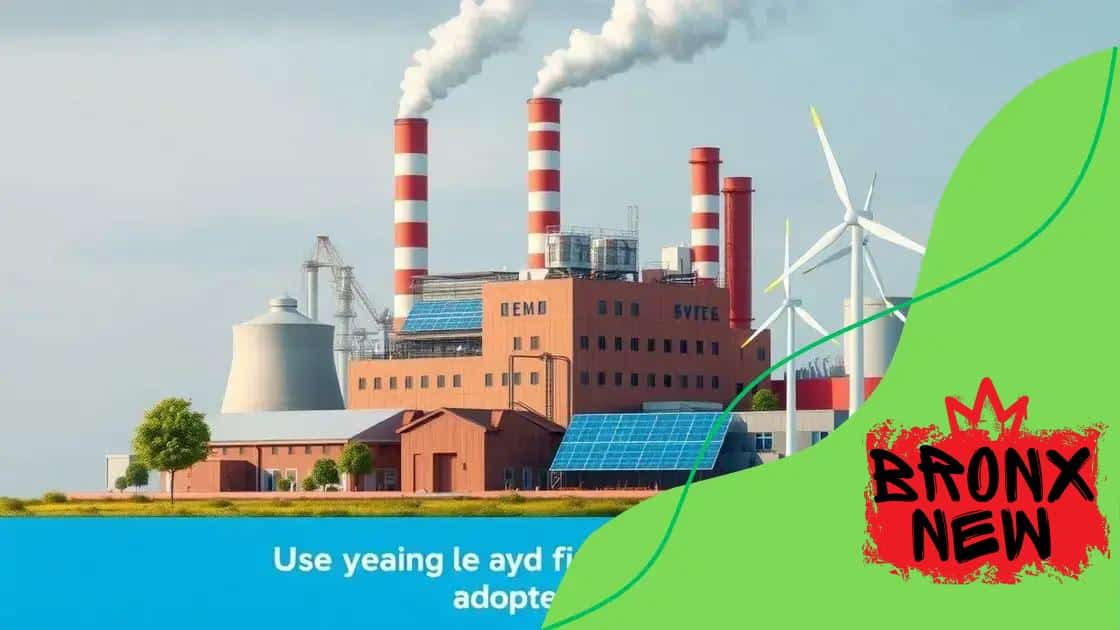Green energy adoption in industrial sectors: a necessity

Green energy adoption in industrial sectors leads to reduced costs, improved efficiency, and enhanced sustainability, while overcoming challenges such as initial investments and regulatory compliance through innovative technologies.
Green energy adoption in industrial sectors is more than a trend; it’s becoming essential for sustainable growth. Have you ever wondered how this shift impacts not just the environment but also operational costs? Let’s dive into the details.
Understanding green energy and its importance
Understanding green energy is essential for industries looking to innovate and reduce their environmental impact. Green energy refers to energy derived from renewable sources, such as solar, wind, and hydroelectric power, which are naturally replenished. The importance of green energy lies not just in its capacity to reduce carbon footprints but also in fostering sustainable practices that benefit both the planet and the economy.
Why Green Energy Matters
Adopting green energy can lead to significant advantages for industrial sectors. Firstly, it can help reduce operational costs in the long run, thanks to lower energy bills and tax incentives. Secondly, many consumers prefer companies committed to sustainability, enhancing brand loyalty and market reach. Furthermore, governments worldwide are increasingly supporting green initiatives through various policies and subsidies.
- Decreased reliance on fossil fuels
- Improved health and environmental outcomes
- Increased job opportunities in renewable sectors
- Greater energy security and independence
Moreover, the transition to green energy often leads to technological advancements within industries. Companies investing in renewable technologies are often at the forefront of innovation. Increased investment in green technologies can pave the way for new job creation and economic growth, bolstering the workforce. Industries can also benefit from improved public relations and stronger community support by demonstrating commitment to reducing their environmental impact.
Challenges in Understanding Green Energy
While the benefits of green energy are impressive, understanding it fully requires addressing several challenges. For one, many industries may find the initial investment cost daunting. However, exploring financing options and government programs can alleviate these concerns. Moreover, there can be a knowledge gap regarding the best practices and technologies available. Nonetheless, with ongoing education and awareness initiatives, industries can successfully bridge this gap and fully embrace green energy solutions.
Benefits of adopting green energy in industries
The benefits of adopting green energy in industries are significant and varied. Transitioning to renewable energy sources not only helps the environment but also improves operational efficiency and can save costs in the long run. Many companies have already started to recognize these advantages and are making the shift.
Cost Savings
Switching to green energy can lead to lower energy bills for industries. This happens because renewable energy sources are often cheaper to harness over time. For instance, solar panels and wind turbines require an initial investment, but they produce energy without fuel costs. Companies could also take advantage of government incentives that reduce the cost of these technologies.
- Reduction in energy costs over time
- Access to tax credits and incentives
- Lower maintenance costs for renewable infrastructure
- Increased resilience against gas price fluctuations
Another major benefit of adopting green energy is the positive impact on company reputation. Consumers today are becoming more eco-conscious and often prefer to support businesses that care about sustainability. By investing in renewable energy, industries can enhance their brand image and connect with a growing market of environmentally-aware customers.
Environmental Impact
Adopting green energy also plays a crucial role in reducing overall greenhouse gas emissions. This shift helps combat climate change and contributes to cleaner air and water. Industries using renewable resources demonstrate their commitment to protecting the planet, inspiring other companies to follow suit.
Additionally, embracing green technologies can drive innovation within industries. Companies often develop new solutions and improvements once they start implementing sustainable practices. This innovation not only benefits the companies themselves but can also lead to broader advancements in technology and energy efficiency.
Challenges faced by industries during adoption

Industries looking to adopt green energy solutions face several challenges. These obstacles can hinder progress and make the transition more difficult. Understanding these challenges is crucial for successful implementation and long-term sustainability.
Initial Costs
One of the most significant hurdles industries encounter is the initial cost of adopting green technologies. Installing solar panels or wind turbines can require a large upfront investment. Many companies worry about whether they can afford such costs, despite the long-term savings.
- High installation costs for renewable technologies
- Budget constraints limiting financial flexibility
- Long payback periods impacting investment decisions
- Need for financing options to support investments
Another challenge is the complexity of integrating renewable energy into existing systems. Many industries have established processes and equipment that are not easily compatible with new technologies. This can lead to operational disruptions while companies work to find solutions.
Regulatory and Compliance Issues
Navigating regulatory and compliance requirements can also be daunting. Different regions have varying laws and incentives related to green energy. Keeping up with changing regulations can be time-consuming and requires dedicated resources. Industries must ensure they comply with these laws to avoid fines or penalties.
The knowledge gap is another significant barrier. Many companies lack the necessary understanding of green technologies and best practices for implementation. This gap can lead to inefficient use of resources and missed opportunities for maximizing potential benefits.
Despite these challenges, many industries are finding ways to overcome them. Collaborations with renewable energy providers and participation in training programs can help bridge the knowledge gap. By addressing these obstacles proactively, companies can successfully navigate the transition to green energy.
Innovative technologies facilitating green energy
Innovative technologies are playing a vital role in facilitating the adoption of green energy in various industries. These technologies not only enhance energy efficiency but also lower costs, making renewable energy sources more accessible.
Advanced Solar Panels
One major innovation in green energy is the development of advanced solar panels. These new models are more efficient than older versions, capturing sunlight better and converting it to electricity at higher rates. Some even come with integrated storage solutions, allowing businesses to use solar energy even when the sun isn’t shining.
- Higher energy conversion rates
- Integrated battery storage options
- Smart tracking systems to optimize sunlight capture
- Durability improvements for longer lifespans
An example of this is solar panels with bifacial technology, which can collect light from both sides, increasing overall production. As manufacturing processes improve, the cost of these advanced panels continues to decrease, making them appealing to industries everywhere.
Wind Turbine Innovations
Wind energy is also benefiting from technological advancements. Modern wind turbines are designed to operate more efficiently and can harness wind energy at lower speeds. These turbines are often smaller and less intrusive, making them suitable for industrial areas where space is limited.
Smart wind energy systems allow for real-time monitoring and adjustments. This means companies can maximize output based on changing weather conditions, improving reliance on wind as a stable energy source.
Hydropower technologies, such as small-scale hydroelectric systems, are emerging as another innovative option. These technologies allow industries to harness water flow without the need for large dams, minimizing environmental impact while generating energy.
These innovative technologies are crucial for advancing the use of green energy. As industries become more aware of their options and the advancements in technology, the switch to renewable energy sources will likely accelerate.
Future outlook for green energy in industrial sectors
The future outlook for green energy in industrial sectors is very promising. As technological advancements continue, many industries are starting to rely more on renewable sources. This shift is not just about protecting the planet; it’s also about financial benefits and improved efficiency.
Increasing Adoption Rates
More companies are adopting green energy solutions as they become more affordable. Solar and wind energy costs have decreased significantly in recent years. As a result, industries are investing in these technologies. This trend is expected to continue, with projections indicating that a larger percentage of energy will come from renewable sources in the near future.
- Wider availability of financing options
- Government policies encouraging renewable energy use
- Corporate sustainability goals driving adoption
- Public awareness of environmental issues promoting change
With companies looking for ways to reduce their carbon footprints, the demand for green energy will only grow. Industries are also finding that sustainable practices can improve public relations and brand loyalty. Consumers increasingly favor companies that take environmental responsibility seriously.
Technological Innovations
As industries embrace green energy, technological innovations will continue to emerge. Innovations in energy storage, such as advanced battery systems, will play a crucial role in the future. These technologies will help manage energy supply and demand more effectively.
Additionally, the integration of smart technology will enhance energy management. For example, IoT (Internet of Things) devices can optimize energy use in real-time, increasing efficiency. Such innovations not only benefit the environment but also drive down costs for businesses.
As industries evolve and adapt to these changes, new job opportunities will arise in the green energy sector. This shift will not only benefit individual companies but also contribute positively to the economy as a whole. Overall, the future of green energy in industrial sectors looks bright, with countless possibilities on the horizon.
FAQ – Frequently Asked Questions about Green Energy Adoption in Industries
What are the primary benefits of adopting green energy in industries?
The primary benefits include reduced operational costs, improved efficiency, enhanced public image, and a positive environmental impact.
What challenges do industries face when adopting green energy?
Industries often face challenges such as high initial costs, complexities in integration with existing systems, regulatory compliance, and a knowledge gap.
How does green energy contribute to job creation?
The shift towards green energy leads to new job opportunities in the renewable energy sector, as companies require more skilled workers to implement and manage these technologies.
What innovative technologies are facilitating the transition to green energy?
Innovative technologies include advanced solar panels, smart wind turbines, and efficient energy storage systems that help maximize renewable energy use.





